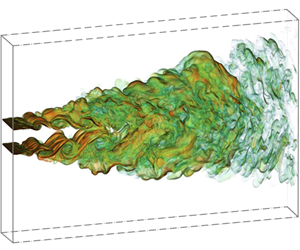Article contents
Direct numerical simulation of a supercritical hydrothermal flame in a turbulent jet
Published online by Cambridge University Press: 09 July 2021
Abstract

The aim of this study is to establish a fundamental understanding of the flame structure and autoignition characteristics of supercritical hydrothermal flames in three-dimensional shear-driven turbulence. The study involves direct numerical simulation of a non-premixed flame (with fuel comprising a mixture of 10 %  $\textrm {H}_2$ and 90 %
$\textrm {H}_2$ and 90 %  $\textrm {H}_2\textrm {O}$ in terms of mole fraction) at 25.0 MPa in a slot jet; detailed reaction mechanism and multispecies real-fluid properties are considered in the simulation. Qualitative transient inspection revealed that the flame undergoes a three-stage development process in the streamwise direction: sparse autoignition kernels in the upstream region, intense ignitions and establishment of a continuous flame surface in the middle region, and massive flamelets in the downstream region. Ignition kernels primarily form in the interior of large-scale shear-driven vortices featuring a low scalar dissipation rate. Probability density function (p.d.f.) analysis further confirmed that these kernels mainly form in the premixed combustion mode and on the fuel-lean side, in contrast to the authors’ previous findings concerning autoignition in a two-dimensional mixing layer. Analysis of the preignition chemistry indicator (i.e.
$\textrm {H}_2\textrm {O}$ in terms of mole fraction) at 25.0 MPa in a slot jet; detailed reaction mechanism and multispecies real-fluid properties are considered in the simulation. Qualitative transient inspection revealed that the flame undergoes a three-stage development process in the streamwise direction: sparse autoignition kernels in the upstream region, intense ignitions and establishment of a continuous flame surface in the middle region, and massive flamelets in the downstream region. Ignition kernels primarily form in the interior of large-scale shear-driven vortices featuring a low scalar dissipation rate. Probability density function (p.d.f.) analysis further confirmed that these kernels mainly form in the premixed combustion mode and on the fuel-lean side, in contrast to the authors’ previous findings concerning autoignition in a two-dimensional mixing layer. Analysis of the preignition chemistry indicator (i.e.  $\textrm {H}_2\textrm {O}_{2}$ radicals) revealed that although the fuel-rich condition has a shorter homogeneous autoignition delay time, it does not exhibit any remarkable preignition chemistry or intense heat release in the upstream or middle regions because of its large-scale flow structure. A volume rendering of the dimensionless Damköhler number (
$\textrm {H}_2\textrm {O}_{2}$ radicals) revealed that although the fuel-rich condition has a shorter homogeneous autoignition delay time, it does not exhibit any remarkable preignition chemistry or intense heat release in the upstream or middle regions because of its large-scale flow structure. A volume rendering of the dimensionless Damköhler number ( $Da$) reveals the distribution of autoignition spots and propagating flames. The joint p.d.f. of the mixture fraction and
$Da$) reveals the distribution of autoignition spots and propagating flames. The joint p.d.f. of the mixture fraction and  $Da$ reveals the transition from sparse ignition to intense ignition and, finally, to flame propagation.
$Da$ reveals the transition from sparse ignition to intense ignition and, finally, to flame propagation.
JFM classification
- Type
- JFM Papers
- Information
- Copyright
- © The Author(s), 2021. Published by Cambridge University Press
References
REFERENCES
- 6
- Cited by





